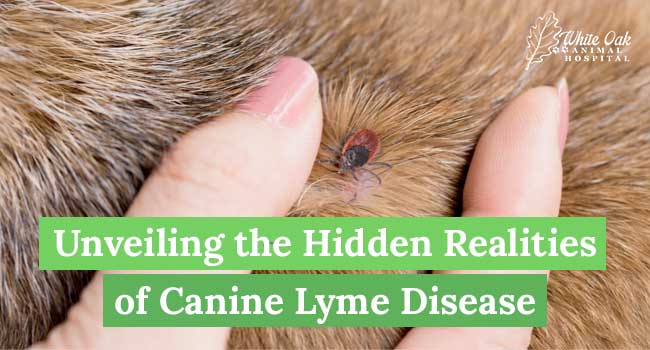
Understanding Canine Lyme disease is vital for the well-being of your furry friend. Lyme disease, caused by the bacterium Borrelia burgdorferi, poses a silent threat transmitted through the bite of infected black-legged ticks. Dogs and horses are susceptible to this infection.
Early detection of the disease’s symptoms is an intricate process. Merely 5-10% of infected animals exhibit clinical signs, often manifesting several months after the initial infection. To address this challenge, timely consultation with your veterinarian is imperative for accurate diagnosis and effective management.
In the pursuit of maintaining your pet’s health, it’s crucial to adopt preventive measures. Implementing rigorous tick control practices and considering vaccination can act as potent shields against Canine Lyme disease. By collaborating closely with your veterinarian and embracing these precautions, you’re taking significant steps to safeguard your cherished companion’s overall well-being and quality of life.
What is Canine Lyme Disease?
Understanding the Intricacies of Canine Lyme Disease
These ticks, they’re everywhere – in woods, tall grass, even your backyard. So, dogs exploring these tick-infested territories, are playing with fire, or in this case, Lyme disease. Now, imagine your dog is one of those that frolics in the woods, rolls in the grass, and ticks on playgrounds. Well, that furry explorer is more susceptible to this unwanted hitchhiker. Also, if you’re living in a Lyme disease hotspot, the risk goes up. And it’s not just location, certain breeds might be more prone to this unwanted visitor. So, keep an eye out for those ticks and know your pup’s risks.
Unveiling the Telltale Signs of Infection
Now, if this disease isn’t caught in its early dance, it can get really serious. Dogs might start having trouble breathing as if they’ve been chasing squirrels non-stop. Their poor joints might start to swell and even a once hearty appetite can go MIA. Ever seen your pup with a droopy face? Well, that’s a late-stage symptom right there – a sign that this disease is pushing them around.
And here’s where early detection becomes the hero in our story. Just like with most things, catching the villain early can mean a better shot at a happy ending. Because if you can nab Canine Lyme disease before it starts throwing its weight around, treatment is often more effective. So, keep an eye out for these symptoms, even the subtle ones, and make sure your canine companion gets the attention they need.
Exploring Diagnosis and Treatment Strategies
When caught early, antibiotics often step in as the heroes, fighting off those pesky bacteria causing all the trouble. Your vet might prescribe doxycycline or amoxicillin. Some folks lean towards a holistic approach, exploring the world of natural remedies. You might find yourself diving into herbal supplements, hoping nature’s arsenal can lend a hand.
Treating Canine Lyme disease isn’t a one-size-fits-all deal. It’s like creating tailor-made armor for your pup’s unique situation. So, consult your vet to guide you through the best strategies. Whether it’s the conventional antibiotic route or a more holistic journey, the end goal is to restore your furry friend’s vitality and keep them wagging their tail.
Effective Strategies to Minimize Canine Lyme Disease Exposure
Canine Lyme disease is no walk in the park. It can bring about a whole heap of trouble for your furry sidekick. We’re talking joint pain, lethargy, fever – the works. Preventing Canine Lyme disease is all about being one step ahead. Preventing this disease is like giving your pup a force field against these sneaky ticks. It’s not just about protecting them from physical discomfort, but also shielding their vitality and zest for life.
- Make tick checks a ritual. After every romp in the great outdoors, give your furry companion a good once-over. Those ticks can be sneaky, but with regular checks, you can catch them before they make themselves too cozy. Complete with thorough inspections to ensure they’re tick-free and beaming with happiness. Your pup will even come to appreciate these little grooming sessions as a sign of your unwavering care and devotion.
- Arm your fur baby with tick-prevention products. These are the ultimate armor against those pesky critters. With options like flea and tick collars, topical treatments, and even oral medications, you’re essentially creating a fortress of protection for your furry sidekick. So, remember, when you gear up your fur baby with these preventive products, you’re giving them the gift of carefree adventures and endless tail wags.
- Keep your outdoor space tidy. Ticks are known to thrive in tall grass and shrubs, so regular yard maintenance plays a pivotal role in reducing their habitat. By keeping your outdoor space trimmed and orderly, you minimize the chances of ticks finding a suitable breeding ground. A well-maintained yard acts as a barrier against tick infestation, allowing your furry companion to explore and play without the risk of encountering these disease-carrying parasites.
- Remember that you’re part of this defense team too. While you’re accompanying your dog outdoors, opt for well-cleared paths and steer clear of densely vegetated or overgrown regions where ticks tend to inhabit. This practice aligns with the concept of a joint effort – you and your dog collaborating to ensure safety. By choosing routes that minimize tick exposure, you’re contributing to the overall preventive strategy.
Dear pet owners, a proactive stance against Canine Lyme disease is a vital safeguard for your cherished companions. This hidden menace can bring about substantial health concerns for your furry friends. Therefore, taking preventive actions is of utmost importance in shielding them from this silent threat.
For those who seek expert guidance in dealing with these concerns, White Oak Animal Hospital is here to assist. The specialized care and insight provided by their professionals can be a guiding light in navigating the complexities of Canine Lyme disease. Remember, your commitment to proactive measures and partnering with reliable veterinary support can lead your furry friends toward a healthier and happier life, unburdened by the shadows of this silent threat.